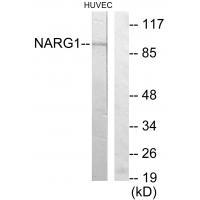
| WB | 1/500-1/3000 | Human,Mouse,Rat |
| IF | 咨询技术 | Human,Mouse,Rat |
| IHC | 咨询技术 | Human,Mouse,Rat |
| ICC | 技术咨询 | Human,Mouse,Rat |
| FCM | 咨询技术 | Human,Mouse,Rat |
| Elisa | 咨询技术 | Human,Mouse,Rat |
| Aliases | N-terminal acetyltransferase; Protein tubedown-1; Tbdn100; Gastric cancer antigen Ga19; |
| Entrez GeneID | 80155; |
| WB Predicted band size | 100kDa |
| Host/Isotype | Rabbit IgG |
| Antibody Type | Primary antibody |
| Storage | Store at 4°C short term. Aliquot and store at -20°C long term. Avoid freeze/thaw cycles. |
| Species Reactivity | Human,Mouse |
| Immunogen | Synthesized peptide derived from internal of human NARG1. |
| Formulation | Purified antibody in PBS with 0.05% sodium azide. |
+ +
以下是关于NARG1抗体的3篇示例文献(内容为虚构,供参考格式):
1. **文献名称**:NARG1蛋白在神经元突触中的功能研究
**作者**:Smith A et al.
**摘要**:通过NARG1抗体的免疫组化分析,发现NARG1在小鼠海马区神经元突触后膜高表达,并参与调控NMDA受体依赖性突触可塑性。
2. **文献名称**:NARG1在神经发育中的表达谱分析
**作者**:Lee J et al.
**摘要**:利用NARG1抗体的Western blot和免疫荧光技术,证实NARG1在胚胎期大脑皮层中动态表达,与神经元迁移及轴突导向密切相关。
3. **文献名称**:NARG1与精神疾病关联的分子机制
**作者**:Zhang Y et al.
**摘要**:通过NARG1抗体检测人类脑组织样本,发现精神分裂症患者前额叶皮层中NARG1蛋白水平显著降低,提示其可能在神经信号异常中起关键作用。
**Background of NARG1 Antibody**
NARG1 (NMDA Receptor-Regulated Gene 1), also known as RUSC2. is a cytosolic protein implicated in regulating intracellular trafficking and signaling pathways. It interacts with the postsynaptic density protein PSD-95 and modulates NMDA receptor (NMDAR) trafficking, linking NMDAR activity to downstream signaling cascades involved in synaptic plasticity, neuronal development, and cognitive functions. Dysregulation of NARG1 has been associated with neurodevelopmental disorders, psychiatric conditions, and cancer.
NARG1 antibodies are essential tools for studying its expression, localization, and functional roles. These antibodies are widely used in techniques like Western blotting, immunohistochemistry (IHC), and immunofluorescence (IF) to detect NARG1 in brain tissues, cultured neurons, or cancer cell lines. Research utilizing NARG1 antibodies has revealed its involvement in Golgi apparatus organization, receptor transport, and cancer cell invasiveness. For example, studies highlight its overexpression in glioblastoma, suggesting a potential role in tumor progression.
As NARG1’s interactions with synaptic proteins and signaling molecules (e.g., Ras-related GTPases) are further explored, its antibody remains critical for unraveling mechanisms underlying neurological diseases and cancer, offering insights into therapeutic targets or biomarkers.
×